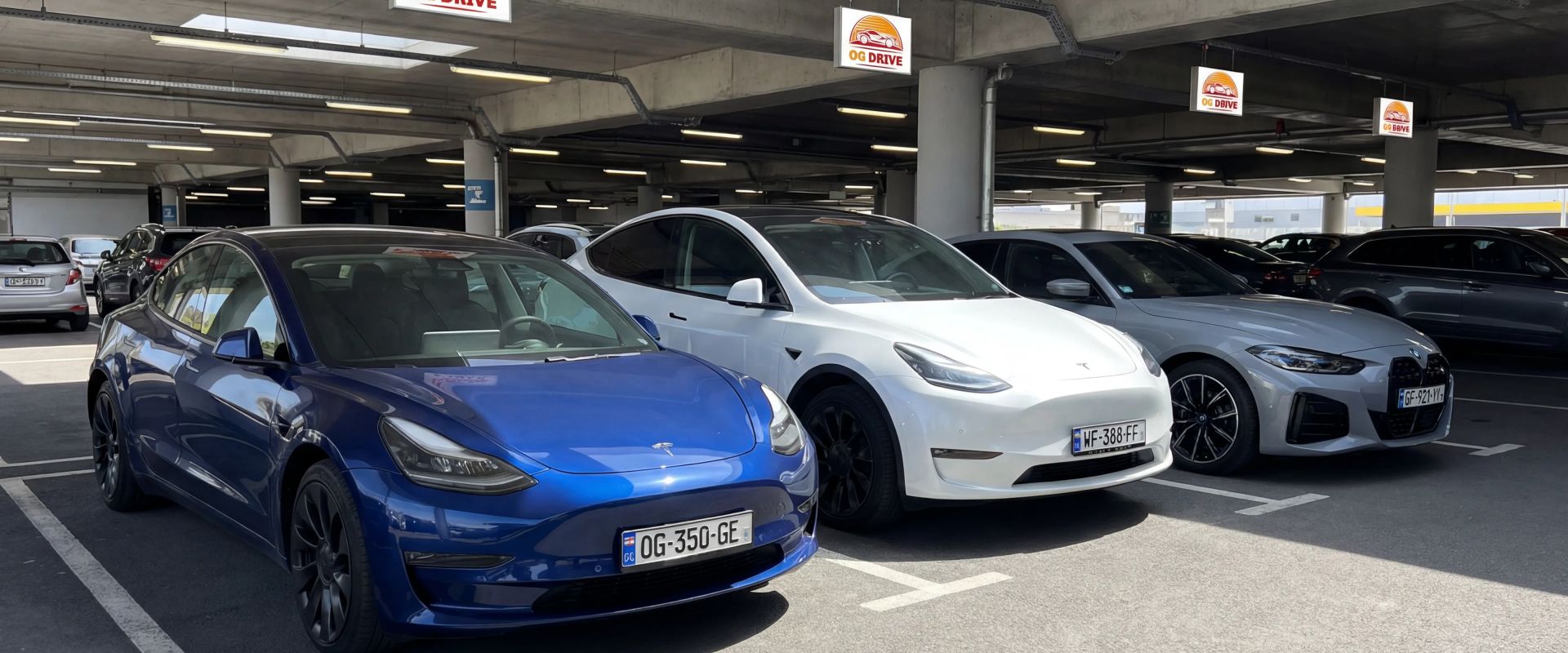Driving Electric Vehicles in Georgia: A Friendly Guide for Tourists and Locals
Georgia’s roads are calling, and there’s no better way to explore them than in an electric vehicle. Whether you’re a visitor touring the wine country or a local heading to the coast, rent electric car in Georgia is an eco-friendly and affordable adventure. In this guide, we’ll walk you through everything you need to know – from charging infrastructure and driving tips to scenic routes and the perks of Tesla rental in Georgia from OG Drive.
Key Takeaways
- Extensive charging network: stations in all major cities and along highways (E-Space, EcoCars, Da-tene, and others).
- Affordable rates: 0.60–0.85 GEL/kWh — 3–4 times cheaper than gasoline.
- 3 charging levels: from a regular socket to fast DC (20–40 min to 80%).
- Travel tips: plan your charges, account for cold weather and mountain routes, use regeneration.
- EV perks: free parking, eco-friendliness, comfortable quiet ride.
Current State of EV Infrastructure in Georgia
EV charging infrastructure in Georgia has expanded rapidly in recent years, covering most regions of the country. You’ll find public charging stations in all major cities and along popular highways – with one notable exception being the remote mountainous area of Svaneti, which currently has no chargers. Importantly, the main highway from Tbilisi to Batumi is well-equipped for EV travel. In fact, E-Space (Georgia’s first EV charging network) has installed 7 fast chargers along the east–west highway, making cross-country trips convenient. This means you can drive from the capital to the Black Sea coast with charging stops available on big stations with fast food shops, supermarkets, toilets (some are paid), pharmacies etc.
Charging Networks and Apps
Several public and private networks operate chargers across Georgia. E-Space alone operates around 150 chargers nationwide, including fast DC stations on highways for long-distance travelers. Other networks like EcoCars Georgia focus on DC fast chargers (often 50–80 kW units). To easily find charging points, it’s best to use smartphone apps:

- E-Space (recommended): Biggest charging network with around 150 chargers nationwide. Offering slow charging stations in Stepatsminda, Zugdidi and across Kakheti region - areas often not covered by other charging networks, but also Fast charging stations in Tbilisi, Batumi and on the highway between.
- EcoCars (Recommended): Mostly fast-charging stations in cities and along major routes. including fast chargers in Gudauri and Kutaisi City Centre - locations where some other networks may be limited.
- PlugShare: A global EV charging map app that shows all stations from every network – very handy for planning routes and seeing driver reviews although can be outdated and have no possibility to actually start the charging process.
- Da-tene App: Useful app with fast charging stations, especially in Kakheti and Akhaltsikhe but also offer other stations in Tbilisi, Batumi and along highway.
- Charger Plus: New chargin networks, key locations includes Gudauri and Lagodekhi.
- ProCredit Stations: Map of free charging stations in Georgia. Includind some unique locations like: Jvari, Ozurgeti, Tskaltubo. Be aware that app does not show the real-time status of stations (availability or whether they are functioning), so you will need to visit the location to check it out.
Charging Costs: One of the best parts of driving an EV is how cheap “fueling” is compared to petrol. Electricity prices at public chargers in Georgia are quite reasonable. On average, slow/Level 2 charging costs about 0.60 GEL per kWh, and fast DC charging about 0.85 GEL per kWh. In practical terms, a full charge for a Tesla Model 3 might cost around 30–40 GEL on a Level 2 charger and roughly 50–60 GEL on a DC fast charger. By comparison, filling a gasoline car for the same driving range would cost several times more. Keep in mind that you pay for the energy, not time (except some networks might charge an idle fee if you stay plugged in after charging). Always check the app for the specific station’s pricing.
Charging Equipment
When renting an electric car with OG Drive, you won’t need to worry about cables or adapters – the car comes equipped with all necessary charging cables, including an emergency charger for a standard household wall socket. This means even in a pinch (say, in a village with no EV station), you can plug into any regular 220V outlet to recharge. While a normal socket charge is slow, it’s a reliable emergency option to have.
EV charging sockets is categorized into three levels, and it’s useful to understand each. You can always compare the socket with the picture below to be sure that you're getting the right socket:
Level 1 – Regular Household Outlet: Using a standard 220V socket (with the portable cable provided) gives the slowest charge. This trickle charge is about 4-5 kW; in practical terms, that means roughly 10-20 km of range per hour of charging. It’s mainly for overnight charging or emergencies. If you plugged a Tesla Model 3 into a normal outlet at 20% battery, it could take around 15 hours to reach 100%. So, Level 1 is not for daily use while touring, but it can add a modest range in case of emergency.
Level 2 – AC Charging (Type 2): These are the most common public chargers in Georgia (you’ll see them at hotels, malls, parking lots, etc.). They use a Type 2 connector and typically output 7 kW (up to 22 kW on some devices). Charging at a Level 2 station is quicker – usually about 5–8 hours for a full charge, depending on your battery size. In many cases, you’ll top up from 20% to 80% in around 3–4 hours. This is perfect for when you’re stopping for a longer period – for example, plugging in your EV while you explore a city, have lunch, or stay the night. Tip: OG Drive provides a Type 2 cable so you can plug into these stations easily. They're usually not equipped with charging cables, so you should use one in the frunk (Front Trunk).
Level 3 – DC Fast Charging (CCS2): DC fast chargers are the quickest way to charge and are available on major routes and some gas stations. In Georgia, most DC fast chargers use the CCS Combo 2 plug. These chargers typically range from 50 kW to 150 kW output. At a 50+ kW station, a Tesla Model 3 can charge from 20% to about 80% in just 20–40 minutes. That’s basically a coffee break or a short meal stop. Fast chargers are ideal for road trips – you can regain a few hundred kilometers of range in the time it takes to stretch your legs. Always ensure you use the appropriate connector (CCS2 for most modern EVs; you can't ChadeMo or GB/T with our Tesla). To use CSS, you need to use the charging adapter included in our car. You first put the adapter on the station’s charging cable, and only after that insert it into the car.
Understanding the correct charging sequence helps avoid errors and ensures safe and efficient charging:
Home charging (regular wall socket)
- Plug the cable first into the wall socket, and only after that into the car.
Slow public charging (Level 2 / Type 2)
- Plug the cable first into the charging station, and only after that into the car.
- Open your charging app in advance and be ready to start charging within one minute after connecting the cable to the car.
Fast charging (Level 3 / DC with adapter)
- First, attach the adapter to the station’s charging cable, then plug it into the car.
- Again, you should start charging through the app within one minute of connecting.
Important:After your session, always stop charging through the app first, and only then unplug the cable from the car. This prevents damage and ensures the charging port unlocks properly.
What to Do If Charging Fails
Charging issues are rare but can happen. Here’s what to do:
-
Disconnect everything and try again – unplug the cable from both ends and restart the process.
-
Check for error messages – most public charging stations display useful info on their screen.
-
Remember the 1-minute rule – many stations require that you begin charging within a minute after plugging in the cable to the car.
-
If using a fast charger, double-check the adapter. There’s a small silver switch button on the back side of the adapter – it must be pressed in for the connection to work.
A Final Note: Don’t Force the Charging Cable from the Car
If the charging cable won’t come out of the car, don’t pull forcefully. Instead, go to the car’s screen and manually unlock the charging port. For Teslas, you can also do this via the app or by pressing the button on the charging cable if available.
Charging Etiquette
With the growing number of EV drivers, it’s important to be courteous at charging spots. Only occupy a charging stall while you are actively charging. Once your car is sufficiently charged (or reaches 80–100%, as needed), unplug and move your car to free up the charger for someone else. This is especially crucial at fast chargers, where others on a road trip might be waiting. Likewise, always leave the charging cable neatly for the next user and report any malfunctions via the app. In Georgia’s EV community, drivers tend to be friendly and cooperative, so following basic etiquette ensures everyone has a smooth experience. You can always ask for an advice from fellow EV driver if you're unsure about something, but also keep in mind that we're also always ready to answer any yout doubts. Don't hesitate to contact us, even if you're not our client :)

Important Tips for First-Time EV Drivers in Georgia
Renting an electric car in Georgia is a smooth and enjoyable experience. Here are some key tips and things to know if it’s your first EV road trip:
Quiet, Smooth Ride: The first thing you’ll notice is how quiet and refined the drive feels. EVs have near-silent electric motors and no gear shifts, so acceleration is very smooth. Telsa model 3,for example, delivers instant power when you press the pedal – you’ll silently zip ahead with instant torque and quick acceleration. This makes merging onto highways or overtaking on mountain roads a breeze. The cabin is quieter than a gasoline car, which means you can better enjoy music, conversations, or the sounds of nature on a scenic drive. And when you lift off the accelerator, the car slows down via regenerative braking – the electric motor works in reverse to brake the car and charges the battery in the process. This one-pedal driving feature may feel different at first, but it quickly becomes intuitive and helps extend your range (plus you’ll use the brake pedal far less).
Trip Planning and Range Management: Georgia is a relatively small country, which is great news for EV drivers. Most destinations are well within the range of modern electric cars. Depending on the EV model, you can expect real-world ranges of about 200–400 km on a full charge. For instance, the Tesla Model 3 that we rent out has a realistic range of around 360–400 km, in good conditions, which means you can drive from the center of Tbilisi to Batumi on the Adjara coast without stopping if you start at 100%. Of course, real range will vary with conditions:
Terrain: Mountainous roads or steep climbs (say you’re driving up to Gudauri or Bakuriani ski areas) will use more energy on the way up. The good news is you regain some energy on the way down thanks to regenerative braking, but you should still plan for extra consumption when heading into high elevations.
Weather: In winter, cold temperatures and use of the heater will reduce your range (batteries are less efficient in cold, and heating draws power). It’s wise to allow a buffer in winter – you might get 20% less range in sub-zero temperatures. In summer, using A/C has some impact but it’s less drastic than winter heating.
Driving Style: Just as with a gasoline car, aggressive acceleration or driving at high highway speeds will consume energy faster. Sticking to the speed limit and using the EV’s eco/regen modes can significantly extend your range.
Planning: To avoid any range anxiety, plan your charging stops ahead of time. Using the apps interactive maps, identify where along your route you can charge. A common strategy is to plan a stop when you’re down to about 20% battery remaining rather than running it nearly to zero. This way, you always have a reserve. For example, if driving from Tbilisi to Batumi (about 370 km), you might plan a fast-charge stop around Kutaisi or Zestaponi when you reach 20–30% – a 30-minute charge there will easily get you the rest of the way. On shorter trips, you might not need to charge at all en route.
Another tip: take advantage of destination charging. Many hotels, wineries, and guesthouses in Georgia are installing chargers or at least will let you plug in. If you stay overnight in Telavi or step away for a few hours in Borjomi, for instance, see if there’s a charger you can use while parked. Even a slow charge for several hours can add significant range for the next leg of your journey. OG Drive’s EVs come with a cable that can plug into any standard outlet, so in case of the locatuins where charging station isn’t around or not working, often a hotel or restaurant will allow you to top up from a regular socket (just ask nicely).
Extra Perks for EV Drivers: Beyond the fuel savings and green credentials, EV drivers enjoy some special perks in Georgia. Notably, electric cars are exempt from public parking fees, so you can park in many areas without paying. EVs in Georgia also don’t have to pay certain taxes and fees that apply to conventional cars, and there’s growing support for electrification to reduce pollution. So by driving electric, you’re not only saving money but often getting preferential treatment. Plus, you can feel good about reducing noise and tailpipe emissions in the beautiful places you’ll visit.
Practical Advices for driving EV in Georgia
Renting an EV in Georgia is generally hassle-free, but like anywhere, there are a few practical challenges to be aware of. Here’s what to keep in mind and how to solve it:
Charging Station Downtime or Availability: Occasionally, you might arrive at a charging station that is temporarily out of service or currently in use by another driver. This is where planning and apps are your friends. Before you set off or while en route, use the apps to check the status of chargers ahead. Many stations have real-time status. It also shows if a station is currently being used (if the network supports live status). Having a Plan B is wise: identify a second charger in the area, just in case. In urban areas there are often multiple options (e.g., if one fast charger in Kutaisi is offline, there might be another at a nearby location or a slower one that can do the job). On highways, E-space’s strategy of multiple fast chargers along the route helps ensure at least one is availble when you need it. In the rare event you find yourself without an available station, remember the backup – a standard outlet. It’s slow, but even 30 minutes plugged into a café’s courtyard socket could give you enough range to reach the next public charger. Solution: Always start long trips with a full charge, use apps to verify charger availability, and don’t push your battery to 0%. Build in a buffer so you have energy to reach an alternate point if needed.
Winter and Cold Weather Driving: Georgia’s winters, especially in the mountains, can be chilly. Cold weather can reduce battery efficiency and thus reduce driving range. Additionally, using the car’s heater (and heated seats, etc.) draws power from the battery. You might notice your range drop faster on a freezing January day in Gudauri than on a mild spring day in Tbilisi. Solution: Plan for extra charging stops in winter. If your EV normally does 300 km on a charge, assume perhaps 180-200 km in very cold conditions to be safe. Preheat the car while it’s still plugged in, so you use grid power to warm it up before departure. While driving, use seat warmers which consume less energy than blasting hot air. And as mentioned, leave with a 100% charge and try not to let the battery get too low – batteries should stay above 20% in cold weather for optimal performance. Fortunately, Georgia’s charging infrastructure is growing even in winter resorts; Bakuriani and Gudauri areas are gradually getting chargers.
Mountain Roads and Terrain: Georgia’s scenic routes often involve winding mountain roads – think of the routes to Kazbegi, Racha, or even the hills of Kakheti. Climbing steep grades uses more energy. For example, if you drive up to Kazbegi, you’ll see the consumption meter in your EV climb. Solution: Factor in the elevation. If your destination is at a much higher altitude than your start, plan an extra cushion of battery. The good part is the return trip (downhill) will be very efficient – regenerative braking can recover a lot of energy on long descents, actually recharging the battery. Sometimes by going down from the mountains you can gain kilometers of range. Still, for the uphill, ensure you have sufficient charge. Use low regen settings on slippery descents in winter (to avoid skidding), but otherwise regen will help control your speed and recoup energy on downhill stretches. For most popular mountain destinations, plan with known chargers on the way and you’ll be fine.
Charging Etiquette & Time Management: A practical challenge on a road trip is making sure charging fits into your schedule. Nobody wants to sit around bored for an hour. Solution: Plan charging stops around meal times or sightseeing breaks. A lunch break or coffee stop is usually “sufficient for using a fast charger, which takes only 30-40 minutes”. So pick a nice restaurant near a charger, plug in, and enjoy Georgian cuisine while your car charges – you’ll come back to a battery ready to go. Many charging locations are strategically placed near cafes, supermarkets, or attractions for this reason. For Level 2 charging, consider doing it when you don’t need the car: for instance, if you’re visiting a museum or park for a few hours, or overnight at your hotel. That way, the charging doesn’t “eat into” your travel time at all – it happens in the background while you’re enjoying your day. By using these strategies, charging stops become a feature, not a bug, of EV travel. They encourage you to take beneficial breaks and discover places (like a cute bakery or viewpoint) that you might otherwise rush past.
Overall, the challenges of EV driving in Georgia are easily managed with a bit of preparation. The infrastructure is improving continuously – hundreds of new chargers are being added, including in regional areas and highways – so any gaps are closing quickly. With the right planning, you can confidently drive an EV here year-round.
Recommended Scenic Routes with EVs

One of the joys of having an electric car is exploring beautiful places with zero emissions and zero engine noise. Georgia offers plenty of breathtaking routes that are perfect for EV road trips. Here are a few scenic drives we recommend, which an EV, like our Tesal Model 3, can comfortably handle:
1. Wine Country Tour in Kakheti: Head east from Tbilisi into Kakheti, Georgia’s famous wine region. An EV road trip here lets you hop between historic towns, vineyards, and monasteries. Start by driving to Sighnaghi, a hilltop town with cobbled streets and views of the Alazani Valley – it’s about 110 km from Tbilisi (easy drive on a full charge). From there, you can drive north-west through the valley to Telavi, the heart of Kakheti, visiting wineries like Tsinandali Estate or Ikano Estate along the way. For more information, check out our wine tour article. Charging tip: Telavi now has a fast charger (80 kW) installed by Da-tene, so you can top up quickly while you have lunch or explore the local market. Next, head to Kvareli (home to the Khareba wine tunnel and Kindzmarauli wine) – Kvareli also boasts a fast charger on the Da-tene network. With chargers in Telavi and Kvareli, doing a loop around Kakheti is stress-free in an EV. Not to mention, many wineries and hotels will allow you to charge (some have Level 2 chargers for guests). On your Kakheti tour, don’t miss the Gremi fortress or the Nekresi monastery perched on a mountain – the quiet EV means you’ll only hear the crickets and wind when you park at these peaceful historic sites. By the time you head back to Tbilisi (roughly 150 km from Kvareli), you can easily have enough charge from Kvareli’s fast charger to make it home. This route combines culture, wine tasting, and scenery – all with the confidence of available charging.
2. Tbilisi to Batumi (with Scenic Detours): Driving from Tbilisi to Batumi on the Black Sea coast is a classic cross-country trip (~370 km via the main highway). In an EV, this journey is not only doable, but enjoyable with a smart stop. Take the E60 highway west from Tbilisi, and consider a quick stop in Mtskheta (only 20 km out, but if you haven’t been, it’s a UNESCO heritage town with the stunning Jvari Monastery overlooking the Aragvi River – a very short detour and a great photo spot). Continuing on, a mid-way stop around Kutaisi is popular. Kutaisi is about 230 km from Tbilisi; by the time you get there, a Model 3 might have ~30% charge left. Plug into a fast charger (there are several around – e.g., E-space fast chargers at gas stations near Zestaponi and Kutaisi) for 30 minutes while you grab a bite. While in the area, you could detour to the Prometheus Cave or Gelati Monastery near Kutaisi, or even the Okatse Canyon if you have extra time – these are some of western Georgia’s natural and cultural highlights. As you approach Batumi, you might also consider a detour to Mtirala National Park (lush rainforest and waterfalls, about 25 km before Batumi) or just head straight into the city. Batumi itself has multiple charging stations (including at malls and hotels) so you can easily recharge the car. Fun fact: Under ideal conditions, the Tesla Model 3 can drive from Tbilisi to Batumi on a single charge, but it’s always wise to charge in between – and the charging stops on this route let you see more sights. The drive offers diverse scenery: rolling green hills, flat plains, and eventually subtropical palm-lined roads in Batumi. And your EV’s regenerative braking will be useful on the downhill stretches if you take any hilly detours.
3. Tsalka & Dashbashi Canyon Nature Trip: For nature lovers wanting a shorter excursion, consider a trip to Tsalka and the Dashbashi Canyon. This route goes south-west from Tbilisi into the Tsalka region, known for its high plateau, lakes, and recently the Dashbashi Canyon, where a stunning glass bridge (with a diamond-shaped cafe in the middle) spans a dramatic gorge with waterfalls. The drive from Tbilisi to Dashbashi Canyon Park is about 100–110 km. It’s an uphill drive into the highlands of Kvemo Kartli, but well within the range of any EV (and you can regain charge on the way back downhill). Currently, Tsalka town and Dashbashi might not have dedicated EV chargers (check PlugShare, as new ones may appear), but you likely won’t need one for a day trip if you leave with a full charge. The total round trip is roughly 200 km. With a Tesla Model 3, you could do that on about 50% of the battery, leaving plenty of buffer. The beauty of this trip is the serenity – as you drive your quiet EV through the alpine meadows and alongside Tsalka Reservoir, you won’t disturb the tranquility. Hikers will enjoy the fresh air at Dashbashi (no exhaust fumes from your car, of course), and the only sounds you’ll hear are birds and waterfalls as you descend into the canyon. Electric vehicles are especially appreciated in nature spots like these. On your return to Tbilisi, you’ll mostly be coasting downhill, possibly gaining a few percent of charge. It’s a refreshing escape from the city and very EV-friendly due to the moderate distance.
These are just a few of many routes. You could also consider driving up the Military Highway to Kazbegi (Stepantsminda) – around 150 km one-way, with beautiful mountain scenery. Chargers exist in routes up to Stepatsminda (150 km out). Or a trip to western Georgia’s Racha region for lakes and mountains (chargers in Kutaisi and Ambrolauri). As Georgia’s infrastructure grows, even remote areas are becoming accessible to EVs. The key takeaway is that an electric car can take you to all the must-see spots in Georgia – from ancient monasteries to national parks – while keeping the air clean and your costs low.
Why Rent an EV from OG Drive
If you’re excited to explore Georgia in an electric car, OG Drive offers the perfect rental experience to make your trip easy and enjoyable. Here’s why renting an EV from OG Drive is a great choice:
All-Inclusive Insurance: OG Drive rentals come with full insurance coverage included in the price. You can drive with peace of mind knowing you’re protected, without paying extra for insurance add-ons. (No hidden fees or deductibles – the terms are transparent and traveler-friendly.)
Unlimited Mileage: Unlike some rentals that limit your kilometers, OG Drive gives you unlimited mileage on all cars. Feel free to roam to every corner of Georgia – drive to Batumi and back, take detours to mountain villages, or extend your itinerary on a whim. There’s no penalty for adding extra distance, so you truly have freedom to explore.
Free Doorstep Delivery & Airport Pickup: To make your journey seamless, OG Drive will deliver the car right to you – be it at your hotel, your home, or the airport – free of charge. When you’re done, we'll pick it up from you as well. This saves you time and the hassle of going to a rental office. After a long flight to Tbilisi or Batumi, imagine stepping out and having a clean, charged Tesla handed over to you immediately. It’s that convenient.
Well-Maintained cars: We're pride of our fleet. The cars are new or late-model, well-maintained, and thoroughly cleaned before each rental. Electric car like the Tesla are inherently low-maintenance (no oil changes, etc.), but OG Drive also ensures the tire pressure, brakes, and all features are in top shape for your trip. You’ll receive the car fully charged and in spotless condition. See our full fleet of vehicles.
Support 24/7: If it’s your first time with a Tesla, don’t worry – the OG Drive team provides a friendly orientation. We will explain and show you all the nuances of using the Tesla in Georgia (charging, using the navigation to find stations, regenerative braking controls, etc.) so that you’re comfortable before you hit the road. During your rental, they are just a message or call away for support (in English, Georgian, or Russian). This level of service is like having a personal guide on standby for any questions about your EV or your route.
Eco-Friendly and Budget-Friendly: By renting an electric car, you’re choosing a greener way to travel. Tesla produce no tailpipe emissions, which helps keep Georgia’s air and scenery clean. Plus, as detailed earlier, you’ll save a lot on fuel costs – electricity is much cheaper than petrol, and some public chargers are free. So not only are you doing good for the environment, but you’re also saving money on your trip. It’s a win-win! OG Drive’s rental rates for EV are also very competitive.
Finally, the experience itself: driving a Tesla around Georgia is just plain fun. It’s a conversation starter at charging stations and a joy on winding roads. With our premium service and the Tesla’s performance, you get a luxurious ride for your adventure.







